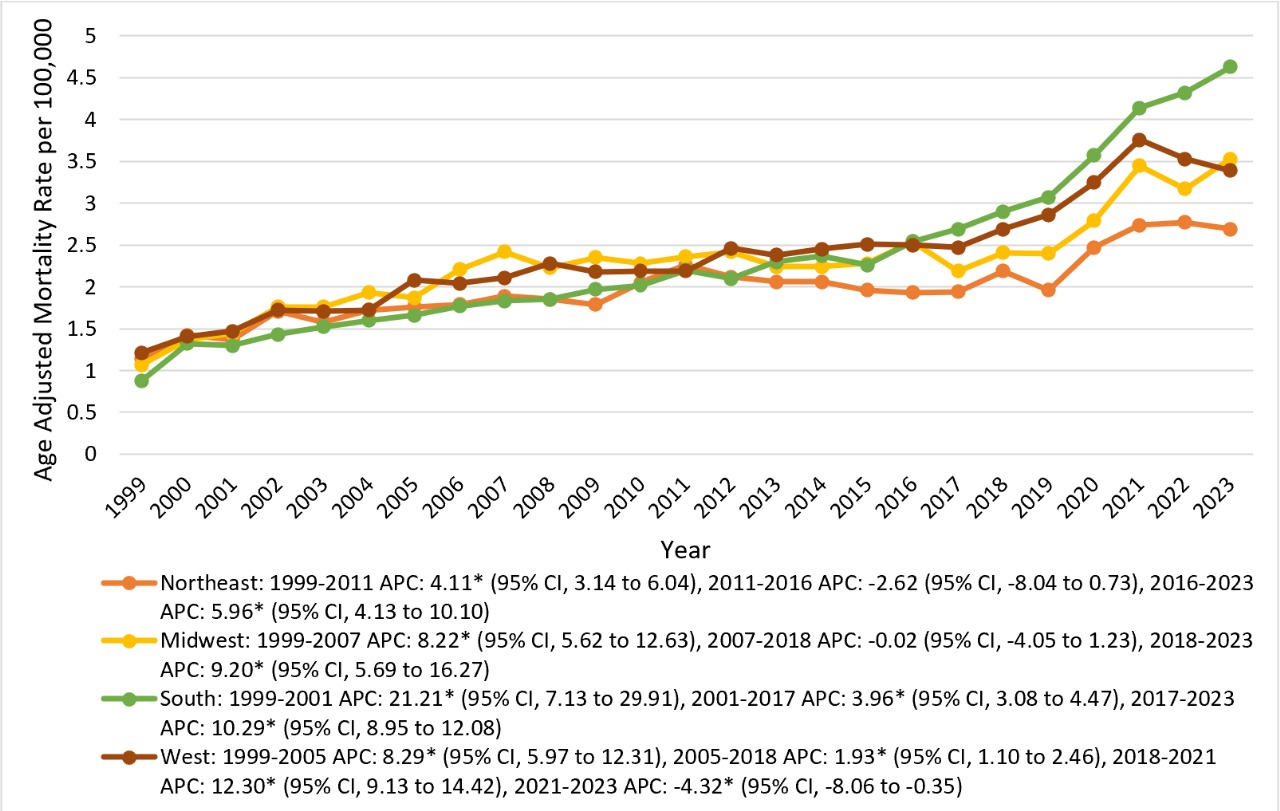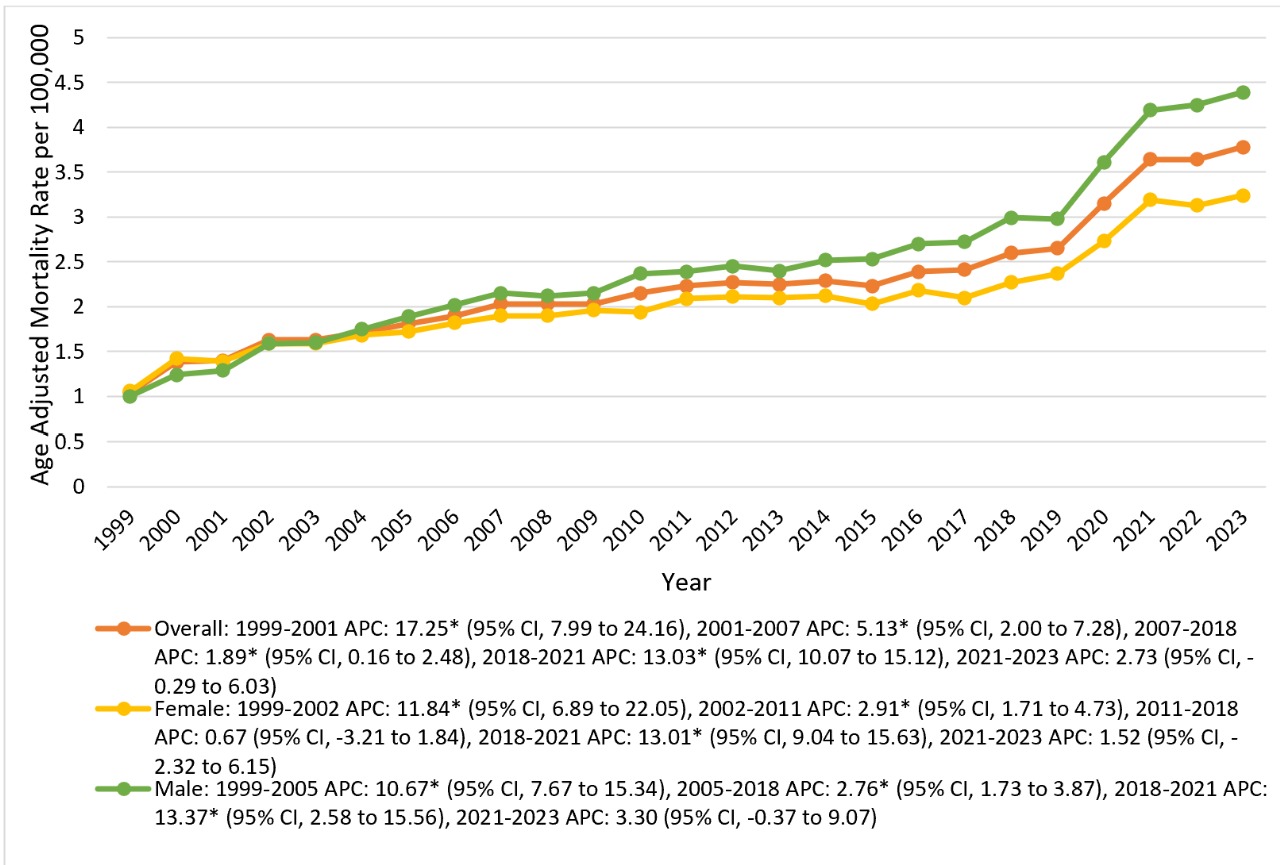Tuesday Poster Session
Category: Biliary/Pancreas
P4325 - Trends in Pancreatic Cancer Mortality With Comorbid Hypertension in the United States, 1999 to 2023: A Retrospective Analysis
Tuesday, October 28, 2025
10:30 AM - 4:00 PM PDT
Location: Exhibit Hall
- RA
Rahila Ali, MD (she/her/hers)
Memorial Hospital at Gulfport
Gulfport, MS
Presenting Author(s)
Rizwana Noor, 1, Sadaf Iftikhar, MBBS2, Rahila Ali, MD3, Sweta Sahu, MBBS4, Muhammed Zulqarnain, MD5
1Khyber Medical College, Peshawar, North-West Frontier, Pakistan; 2Akhtar Saeed Medical and dental college, Lahore, Punjab, Pakistan; 3Memorial Hospital at Gulfport, Gulfport, MS; 4J.J.M. Medical College, Bhubaneswar, Orissa, India; 5University of Kentucky, Bowling Green, KY
Introduction: Pancreatic cancer is a highly aggressive malignancy with poor prognosis and increasing incidence worldwide. Hypertension (HTN), a common chronic condition, may affect pancreatic cancer outcomes and mortality. This study examines mortality trends and disparities in pancreatic cancer among adults(≥45) with HTN in the United States from 1999 to 2023.
Methods: This retrospective study utilized CDC WONDER data to analyse pancreatic cancer (C25) mortality with coexisting HTN (I10–I15) in the United States from 1999 to 2023. Crude and age-adjusted mortality rates (AAMRs) per 100,000 were extracted. Joinpoint regression was employed to calculate annual percent change (APC) and average annual percent change (AAPC) with 95% confidence intervals.
Results: Pancreatic cancer with comorbid HTN resulted in 71,301 deaths over 25 years. The overall AAMR rose from 0.98 to 3.78, with an AAPC of 5.33 (95% CI: 4.88 to 5.79). AAMRs increased sharply from 1999 to 2001 (APC: 17.25, 95% CI: 7.99 to 24.16), followed by a moderate rise till 2007 (APC: 5.13, 95% CI: 2.00 to 7.28). Slower growth was seen from 2007 to 2018 (APC: 1.89, 95% CI: 0.16 to 2.48), then a spike from 2018 to 2021 (APC: 13.03, 95% CI: 10.07 to 15.12), and a plateau from 2021 to 2023 (APC: 2.73, 95% CI: -0.29 to 6.03). Men consistently exhibited higher mortality rates than women and the trajectory of increase was steeper in men (6.02, 95% CI: 5.61 to 6.64) compared to women (4.42, 95% CI: 4.01 to 5.04) All racial groups showed rising mortality, with the greatest rise seen in Non-Hispanic (NH) Whites (AAPC: 6.10, 95% CI: 5.48 to 7.11).
Regionally, the South experienced the steepest rise (AAPC: 6.86, 95% CI: 6.17 to 7.47). Non-metropolitan areas exhibited higher AAMRs than metropolitan areas plus the increase in mortality was also steeper in non-metropolitan areas (5.10, 95% CI: 4.58 to 6.05). Age-stratified analysis showed the 45–54 age group with the sharpest increase (AAPC: 7.81, 95% CI: 7.07 to 8.91). Most deaths occurred in decedent’s home (48.25%).
Discussion: Pancreatic cancer with comorbid HTN mortality has significantly increased over the past 25 years, with higher mortality rates observed in men, NH Whites, and residents of the South. Mortality rates were also consistently higher in non-metropolitan areas compared to metropolitan ones. These findings highlight the growing burden of pancreatic cancer with HTN and the need for targeted public health interventions to address this trend.

Figure: Figure 1. Trends in age-adjusted mortality rates per 100,000 for pancreatic cancer with comorbid hypertension, stratified by sex in the United States (1999–2023).

Figure: Figure 2. Trends in age-adjusted mortality rates per 100,000 for pancreatic cancer with comorbid hypertension, stratified by U.S. census regions (1999–2023).
Disclosures:
Rizwana Noor indicated no relevant financial relationships.
Sadaf Iftikhar indicated no relevant financial relationships.
Rahila Ali indicated no relevant financial relationships.
Sweta Sahu indicated no relevant financial relationships.
Muhammed Zulqarnain indicated no relevant financial relationships.
Rizwana Noor, 1, Sadaf Iftikhar, MBBS2, Rahila Ali, MD3, Sweta Sahu, MBBS4, Muhammed Zulqarnain, MD5. P4325 - Trends in Pancreatic Cancer Mortality With Comorbid Hypertension in the United States, 1999 to 2023: A Retrospective Analysis, ACG 2025 Annual Scientific Meeting Abstracts. Phoenix, AZ: American College of Gastroenterology.
1Khyber Medical College, Peshawar, North-West Frontier, Pakistan; 2Akhtar Saeed Medical and dental college, Lahore, Punjab, Pakistan; 3Memorial Hospital at Gulfport, Gulfport, MS; 4J.J.M. Medical College, Bhubaneswar, Orissa, India; 5University of Kentucky, Bowling Green, KY
Introduction: Pancreatic cancer is a highly aggressive malignancy with poor prognosis and increasing incidence worldwide. Hypertension (HTN), a common chronic condition, may affect pancreatic cancer outcomes and mortality. This study examines mortality trends and disparities in pancreatic cancer among adults(≥45) with HTN in the United States from 1999 to 2023.
Methods: This retrospective study utilized CDC WONDER data to analyse pancreatic cancer (C25) mortality with coexisting HTN (I10–I15) in the United States from 1999 to 2023. Crude and age-adjusted mortality rates (AAMRs) per 100,000 were extracted. Joinpoint regression was employed to calculate annual percent change (APC) and average annual percent change (AAPC) with 95% confidence intervals.
Results: Pancreatic cancer with comorbid HTN resulted in 71,301 deaths over 25 years. The overall AAMR rose from 0.98 to 3.78, with an AAPC of 5.33 (95% CI: 4.88 to 5.79). AAMRs increased sharply from 1999 to 2001 (APC: 17.25, 95% CI: 7.99 to 24.16), followed by a moderate rise till 2007 (APC: 5.13, 95% CI: 2.00 to 7.28). Slower growth was seen from 2007 to 2018 (APC: 1.89, 95% CI: 0.16 to 2.48), then a spike from 2018 to 2021 (APC: 13.03, 95% CI: 10.07 to 15.12), and a plateau from 2021 to 2023 (APC: 2.73, 95% CI: -0.29 to 6.03). Men consistently exhibited higher mortality rates than women and the trajectory of increase was steeper in men (6.02, 95% CI: 5.61 to 6.64) compared to women (4.42, 95% CI: 4.01 to 5.04) All racial groups showed rising mortality, with the greatest rise seen in Non-Hispanic (NH) Whites (AAPC: 6.10, 95% CI: 5.48 to 7.11).
Regionally, the South experienced the steepest rise (AAPC: 6.86, 95% CI: 6.17 to 7.47). Non-metropolitan areas exhibited higher AAMRs than metropolitan areas plus the increase in mortality was also steeper in non-metropolitan areas (5.10, 95% CI: 4.58 to 6.05). Age-stratified analysis showed the 45–54 age group with the sharpest increase (AAPC: 7.81, 95% CI: 7.07 to 8.91). Most deaths occurred in decedent’s home (48.25%).
Discussion: Pancreatic cancer with comorbid HTN mortality has significantly increased over the past 25 years, with higher mortality rates observed in men, NH Whites, and residents of the South. Mortality rates were also consistently higher in non-metropolitan areas compared to metropolitan ones. These findings highlight the growing burden of pancreatic cancer with HTN and the need for targeted public health interventions to address this trend.

Figure: Figure 1. Trends in age-adjusted mortality rates per 100,000 for pancreatic cancer with comorbid hypertension, stratified by sex in the United States (1999–2023).

Figure: Figure 2. Trends in age-adjusted mortality rates per 100,000 for pancreatic cancer with comorbid hypertension, stratified by U.S. census regions (1999–2023).
Disclosures:
Rizwana Noor indicated no relevant financial relationships.
Sadaf Iftikhar indicated no relevant financial relationships.
Rahila Ali indicated no relevant financial relationships.
Sweta Sahu indicated no relevant financial relationships.
Muhammed Zulqarnain indicated no relevant financial relationships.
Rizwana Noor, 1, Sadaf Iftikhar, MBBS2, Rahila Ali, MD3, Sweta Sahu, MBBS4, Muhammed Zulqarnain, MD5. P4325 - Trends in Pancreatic Cancer Mortality With Comorbid Hypertension in the United States, 1999 to 2023: A Retrospective Analysis, ACG 2025 Annual Scientific Meeting Abstracts. Phoenix, AZ: American College of Gastroenterology.
